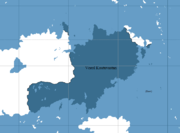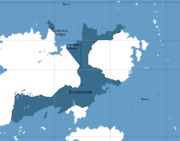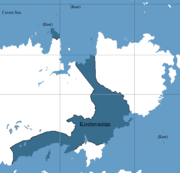Difference between revisions of "Kostuvastan"
Tuvaltastan (Talk | contribs) (→Revolutionary Era (1792-1864)) |
Tuvaltastan (Talk | contribs) (→Post-Imperial Kostuvastan (1894-1985)) |
||
| Line 97: | Line 97: | ||
During this era of chaos and civil unrest, the Baykalian people attempted to secede from Kostuvastan, taking advantage of the pandemonium. They managed to secede, and Caltharus and Kostuvastan both attempted to annex the territory soon after. When Baykalia suffered extreme poverty for five years, Baykalia willingly chose to be annexed by Kostuvastan, at the frustration of many Caltharusians. The Codexian empire had also been gradually pushing Kostuvians out of eastern Aurora during this era, slowly taking large chunks of land at a time through purchases and battles. | During this era of chaos and civil unrest, the Baykalian people attempted to secede from Kostuvastan, taking advantage of the pandemonium. They managed to secede, and Caltharus and Kostuvastan both attempted to annex the territory soon after. When Baykalia suffered extreme poverty for five years, Baykalia willingly chose to be annexed by Kostuvastan, at the frustration of many Caltharusians. The Codexian empire had also been gradually pushing Kostuvians out of eastern Aurora during this era, slowly taking large chunks of land at a time through purchases and battles. | ||
| − | ==Post-Imperial Kostuvastan ( | + | ==Post-Imperial Kostuvastan (1814-1985)== |
(''Main article: [[Post-Imperial Kostuvastan]]'') | (''Main article: [[Post-Imperial Kostuvastan]]'') | ||
[[File:DemocMap.png|thumbnail|right|Kostuv Borders during the 1910's]] | [[File:DemocMap.png|thumbnail|right|Kostuv Borders during the 1910's]] | ||
Revision as of 18:17, 14 September 2018
| The Grand Monarchy of Kostuvastan,
then The Grand Republic of Kostuvastan Cstv'hstah
| |||||
|---|---|---|---|---|---|
|
|||||
|
|||||
| Capital | Port Barnaul, later Chita, then Novosibirsk | ||||
| Largest city | Port Barnaul, later Novosibirsk, then Tarov | ||||
| Demonym | Kostuvian, Kostuvan, Kostuv | ||||
| Government | Absolute monarchy, later democracy | ||||
| Currency | Kostinar, later the Kostuv Credit | ||||
HISTORY RECONSTRUCTION IS IN PROGRESS; INFORMATION ON THIS PAGE IS NOT ENTIRELY ACCURATE
Kostuvastan was a nation that stretched throughout the middle of Aurora, and was separated after its civil war. It bordered the countries Caltharus and Ethalria. The nation was replaced by the nations Tuvaltastan, Tivot, Kostromastan, Imperial Fandom, and Baykalia, and is the successor to the Kostuvian Empire.
Contents
History
Dynastic Kostuvastan (12-1894)
To start off, a dynasty is defined by when the last name of the King or Queen is changed, the offspring of a dynasty change their last name, or a major revolution occurs.
Slovin Dynasty (12-396)
(Main Article: Early Kostuvastan)
Prior to the founding of Kostuvastan, the area was filled with small kingdoms and citystates. Rorik von Slovinich was born a royal in the citystate Kosturol. Upon taking up the position of Noble of Kosturol, Slovinich declared himself the first king of a new empire. The Nobility of Kosturol became The Grand Monarchy of Kostuvastan. Through raids and marriages, Kostuvastan gradually established itself as a small nation, much larger than Kosturol, and a cultural divide soon developed: The high class inhabitants of Kristoa, now modern-day Chita, and the farming peasants that lived in the rest of the nation. The Kristoans were typically appointed by the king to high-ranking positions, and kept much of the wealth away from the rest of the country. A major example of the divide between noble and peasant was the infrastructure within the territory. The infrastructure, which included the first mailing system and a series of roadways, only serviced Kristoa and the immediate surrounding area, leaving the rest of the nation lacking in infrastructure. The Slovin Dynasty was predominantly defined by its struggles and skirmishes with neighboring tribes and kingdoms to keep its sovereignty.
Wolon Dynasty (396-827)
Jeoffery Wolonovich, formerly known as Jeoffery Slovinich, was the son of King Rorik IV, and was basically a rebellious teenager who did not want to be in the same dynasty has his father, and changed his name in order to do so. If Jeoffery Wolonovich did not change his last name, it would be very likely that the Slovin Dynasty would be much longer. The Wolon dynasty ironically followed in the footsteps of the Slovin Dynasty, and had a very similar industrious nature to the Slovin Dynasty. The founder of the Wolon Dynasty was nonetheless very influential, and continued the expansion of Kostuvastan, as did his predecessors before him. The first Queen of Kostuvastan also came to power during this Dynasty, known as Tanya Wolonovich. Her reign was filled with scandal, with Tanya apparently having been in three affairs while married to her husband, two of those affairs occurring at the same time. Nonetheless, Tanya Wolonovich birthed a total of 14 children, all but one were illegitimate for the throne, the only legitimate one being Rorik Wolonovich, later Rorik Lewinski.
Lewin Dynasty (827-895)
(Main Article: Lewin Dynasty)
Rorik Lewinski was the only king in this dynasty, and was not very liked. Quite gluttonous, Lewinski exploited his kingdom through taxes and became the richest and fattest Kostuva King ever, weighing in at 293 pounds and with a wealth of $130,000,000,000 in ISD. This hoarding of wealth and gluttony resulted in the nation becoming immensely poor. The people of Kostuvastan as a result executed Lewinski by beheading via Rotary Guillotine, along with his three sons, leaving Lewinki's daughter, who was loved by the people, the throne. Lewinski was executed at the age of 106, making him the oldest monarch in Kostuvastan.
Qurala Dynasty (895-1214)
(Main article: Qurala Dynasty)
Beatrice Quralanolovich, who changed her last name to be as different from her father's last name so as to remove all connections with him, was the first Queen of Kostuvastan, and never married. Extremely liked, Quralanolovich removed all the unneccessary taxes inflicted upon the public by her father, and grew the economy by establishing trade routes with neigboring Ethalria, Dragonia, Xagurg, Oceansend, and Staynes. With no heir, due to Beatrice being sterile, and with no other family member willing to take the throne, Beatrice adopted a son, who became the root of the rest of the royal family tree.
Kostuv Interregnum (1214-1352)
(Main Article: Kostuv Interregnum)
This era consisted of many incompetant monarchs who, for a century (1247-1347), did not work to keep the Kostuv monarchy and government from failing, which it inevitably did in 1330 upon the succession of King Ivanolov Quralanolovich III, along with twin brother Ivanovich Quralanolovich II. This dual monarchy completely split the empire in two (the northern Rukin dynasty and the southern Alvonic dynasty), resulting in the central plains separating for a time from Kostuvastan, forming the first variation of Kostromastan, and the area around Lake Nilovi gaining independence, forming the first iteration of Imperial Fandom. It took the Molgov Dynasty monarchs another century and a half to restore relations with the neighboring states, and to reunite the empire back together, including the short-lived first iterations of the nations of Kostromastan and Imperial Fandom.
Molgov Dynasty (1352-1786)
(Main Article: Molgov Dynasty)
The Molgov Dynasty is the longest-running dynasty in Kostuv history. Taking the economic policies of the Qurala Dynasty, and the industriousness of the Wolon and Slovin dynasties, the Molgov Dynasty improved every aspect of the Kostuva way of life. These centuries of prosperity eventually led to the invention of the Auralgraph and the steam engine in later years. During the end of this dynasty, Codexian settlers began settling in the area east of the empire, what would soon evolve into the nation Xiopothos.
Vorolov Dynasty (1786-1792)
Like the Lewin Dynasty, the Vorolov Dynasty only had a single monarch, named Rorin Vorolov. Known as Rorin the Terror, Vorolov killed millions, but the exact number is unknown. Estimates range from as little as 2,000,000 to as much as 15,000,000. Nonetheless, Vorolov and his army attempted to conquer Aurora, but only managed to take the area west of the Morstaybishlian Mountains, and the Codexian colony in northeast Aurora. The last official monarch of Kostuvastan, Rorin Vorolov had only one son with a mistress (making him illegitimate to be an heir), named Lurin Vorolov I, who would inherit the riches of his father.
Revolutionary Era (1792-1814)
(Main article: Kostuv Revolutionary Era)
During this era of chaos and civil unrest, the Baykalian people attempted to secede from Kostuvastan, taking advantage of the pandemonium. They managed to secede, and Caltharus and Kostuvastan both attempted to annex the territory soon after. When Baykalia suffered extreme poverty for five years, Baykalia willingly chose to be annexed by Kostuvastan, at the frustration of many Caltharusians. The Codexian empire had also been gradually pushing Kostuvians out of eastern Aurora during this era, slowly taking large chunks of land at a time through purchases and battles.
Post-Imperial Kostuvastan (1814-1985)
(Main article: Post-Imperial Kostuvastan)
After the Revolutionary Era came to a close, the people of Kostuvastan slowly developed a leadership that they were comfortable with, known as the Second Republic of Kostuvastan. The first Chancellor of this new republic was Mikhail Karanovich, who would go down in history as the greatest and most influencial leader of Kostuvastan, having revamped the infrastructure first established during the Qurala Dynasty and Molgov Dynasty. The Second Republic would continue to exist as the recognized government until the Kostuv Civil War in 1985.
Decline of Kostuvastan
Kostuv Participation in The Auroran Imperial War
From the beginning to the middle of the 1970's, Kostuvastan was on the Empirical side of The Auroran Imperial War, and spent much of its participation attacking and defending the western border of Kostuvastan. Imperial Fandom had successfully acquired independence shortly before the war, and joined the Allies.
Kostuv Civil War
The Kostuv Civil War was by far the most devastating war in Kostuv history, and arguably one of the deadliest in Urth's history. Killing around 60 million people through direct and indirect means, the war resulted from an ingrained resentment felt by Kostroms and Tuvalts towards the Baykalians, who held the majority in both the upper and lower houses of legislature, and passed legislature that would maximize Baykalian influence and minimize Kostrom and Tuvalt influence in elections and in legislature. With numerous protests, both peaceful and violent, occurring within the decade before, the oppressed and unrepresented majorities of Kostroms and Tuvalts revolted against the Baykalians, officially starting the war in 1985. It would be another two decades, and numerous battles, airstrikes, and deaths, until the war would officially end in 2005.
Economy
Thanks to the diverse geography and relatively large size of the nation for most of its life, Kostuvastan was a major regional and somewhat influential power globally (due to position between Gondwana and Yasteria). Controlling the entrace to Aurora from the Pacific allowed for the nation to prosper, especially under the Qurala and Molgov Dynasties, and the Imperial Era. From the port city of Tarov to the industrial centers of Chita, Shagonar, and Novokuznetsk, Kostuvastan was set to become a powerhouse economy. The Civil War completely and utterly destroyed that, with the economy barely surviving the humanitarian crisis that came about during and after the war. Tivot, due to it gaining independence shortly after the Auroran Imperial War, maintained the growth levels of former Kostuvastan, itself becoming a major financial hub.
Culture
Tivot
Tivot, although having been a part of Kostuvastan since 847 AD, was always culturally and geographically separate from the rest of Kostuvastan. This separation from the mainland resulted in other cultures having a large influence in the way Tivotians lived their lives. Nations like Caltharus, Staynes, East Malaysia, and FPS all had cultural additions to combine into the Tivotian culture. This ended up fueling Tivot's independence movement in 1975. Very business-focused, a number of prominent Tivotians have developed the mindset of "succeed for the betterment of Tivot" and put the nation first.
Northern Baykalia
Separated from the rest of Kostuvastan via the Kalivian Mountains, northern Baykalia developed a culture distinct from the rest of the nation. Baykalians value collectivism over individualism, and value the family above all. Religion plays a large part in this region, with North Kotvarianism being the dominant religion. In recent years, the Posol Family has worked to replace Kotvarianism with their own state-sponsored religion wherein the Posols are the saviors of the Baykalian people.
Central Kostuvastan
Southern Baykalia, all of Kostromastan, and Northern Tuvaltastan make up this largest section of Kostuvastan. All within the Great Auroran Desert, these regions have many festivals to celebrate the Salov river, the bloodline of most of the Great Auroran Desert. These festivals stem from Ancient Kostuvian traditions, and have stood the test of time.
Southern Tuvaltastan
Taking a very "every man for himself" ideology, Tuvaltastan is a culture focused on the concept that success will make one happy. Parents are known to kick their children out of the house after their eighteenth birthday, a practice that many believe is a contributing factor to increased anxiety and stress seen in each consecutive generation.






